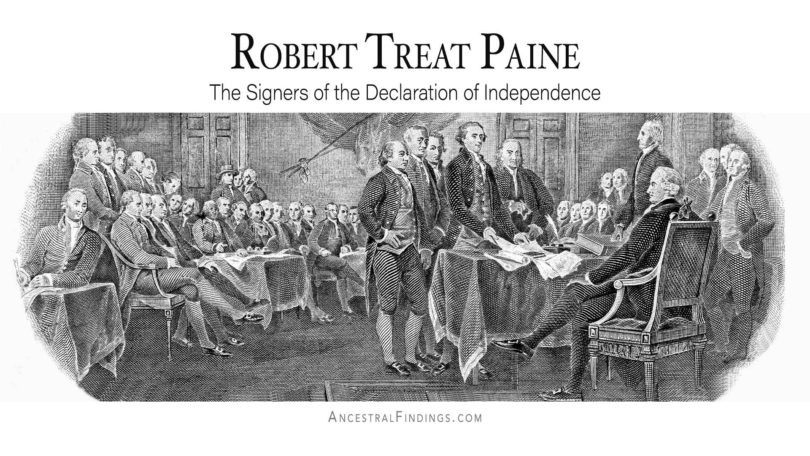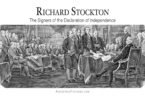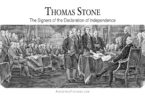Robert Treat Paine was born in March of 1731 in Boston, Massachusetts, one of five children of the Reverend Thomas Paine and Eunice Treat. Thomas was the pastor at the Franklin Road Baptist Church in Weymouth, Massachusetts before Robert was born, but moved the family to Boston in 1730, where he became a merchant. Eunice was the daughter of the Reverend Samuel Treat, and her grandfather, Major Robert Treat, was one of the founders of Newark, New Jersey, and a later Governor of Connecticut. On Robert’s dad’s side, the family had a lineage going back to The Mayflower.
As a child, Robert went to the Boston Latin School and enrolled in Harvard College when he was fourteen years old. Robert graduated from Harvard when he was eighteen years old, at which point he became a school teacher for several years, teaching at his old alma mater, Boston Latin School. He also taught in the town of Lunenburg, Massachusetts.
In addition to teaching, Robert attempted to become a merchant like his dad, and he made several trips to the Carolinas in this endeavor. He also went to the Azores and to Spain in merchant pursuits, and even went to Greenland on a whaling voyage. When he was twenty-four years old, Robert studied law with a cousin of his mom’s in Lancaster, Massachusetts. He tried to get an officer’s commission in the Lancaster regiment but was not given one, so he volunteered to serve as the regiment’s chaplain. Robert went on a brief military campaign with the regiment to Lake George (it was called the Crown Point Expedition).
When he came home from the campaign, Robert did some occasional preaching while he resumed his legal studies. When he was twenty-five years old, he moved back to Boston to finish up his preparations for embarking on a legal career, with Samuel Prat as his mentor. Robert was admitted to the bar when he was twenty-six years old. Robert considered establishing a law practice in Portland, which was part of Massachusetts at the time but is now part of Maine. Instead, he moved to Taunton, Massachusetts in 1761, then back to Boston in 1780.
In the interim between being in Taunton and Boston, Robert was a delegate to the Provincial Convention in 1768, which met in Boston. Robert went, along with Samuel Quincy. While there, the two of them were the prosecutors in the case against Captain Thomas Preston and his regiment of British soldiers after the Boston Massacre in March of 1770. The future second President of the United States, and also future fellow Declaration signer John Adams was the defense lawyer in this same case. Adams managed to sway the jury, and the British soldiers were declared innocent and set free.
Robert served on the Massachusetts General Court from 1773 to 1774 and was a member of the Provincial Congress from 1774 to 1775. In 1774, he was appointed as a delegate to the Continental Congress, where he served until 1776, and where he became a signer of the Declaration of Independence. Also while serving on the Continental Congress, Robert was one of the signers of the Olive Branch Petition in 1775, which was the last appeal the Congress made to the British king before declaring independence. Robert also assisted the Congress in acquiring gunpowder for the American Revolution before it officially started (as the Congress knew the colonies were heading that way), and also assisted in framing the official rules for debate at the Congress.
After leaving the Congress at the end of 1776, Robert became the speaker of the Massachusetts House of Representatives. He was also a member of the executive council of the House in Massachusetts, and a member of that group’s committee that drafted the Massachusetts state constitution in 1780. Robert was the Attorney General of Massachusetts from 1777 to 1790 and was the prosecutor in the treason trials that followed Shay’s Rebellion. Robert was made a charter member of the American Academy of Arts and Sciences in 1780. From 1790 to 1804, Robert served as a justice on the Massachusetts state supreme court. After that, he retired from public life.
Robert crossed over to the other side in 1814 at eighty-three years old and was buried in the Granary Burying Ground in Boston. There are numerous papers written by him that are today held at the Massachusetts Historical Society. These papers include his legal notes, as well as professional and personal correspondence.
Religion was important to Robert, as it was to most of his friends and family at the time, and not least of which because his dad was a minister. Robert was a devout Congregationalist, which is what the Puritan religion eventually became after a few generations in America. Yet, Robert was devoted to his actual church, as well. When the church he attended, the First Church of Boston, changed its denomination from Congregationalist to Unitarianism, Robert went along with them and became a Unitarian along with the other members of the church who chose to stay after the change.
Robert married Sally Cobb, a daughter of Thomas Cobb and Lydia Leonard, and a sister of General David Cobb, in March of 1770. Sally was born in May of 1744 and crossed to the other side in June of 1816. Together, they had eight children, all of whom lived past childhood, some of whom married, but only two of whom had children of their own. These eight children consisted of four sons and four daughters. None of the daughters had children of their own, two of them married, and two lived well into their adult years, but never married or had children. Of the sons, at least three of the four went to Harvard College. Two did not marry or have children. The other two both married and had children. While Robert is not one of the most famous or best remembered signers of the Declaration of Independence today, there are a few tributes to him in modern American society. There is a statue of him, created by Richard Brooks, located on the church green at Taunton, Massachusetts, erected there in 1904. Robert is also an honoree at the Washington D.C. memorial to the fifty-six signers of the Declaration of Independence.







